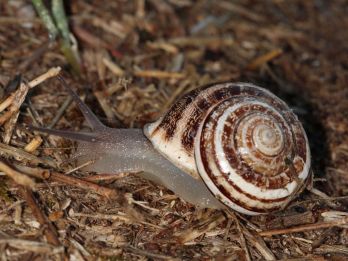Chocolate-band snail
Massylaea vermiculata, also known as Eobania vermiculata or Helix vermiculata, is commonly named the chocolate-band snail. It is a terrestrial pulmonate gastropod mollusc in the family Helicidae.
Background
This species of large land snail is common in the Mediterranean area, ranging from eastern Spain to the Crimea.
The chocolate-band snail is occasionally detected at quarantine intervention points (wharf inspection areas) on the outside of containers around Australia.
Impacts
This invasive species is considered a potentially serious threat to Australia. It could negatively affect:
- agriculture
- natural ecosystems
- human health
- commerce.
The chocolate-band snail have a long lifespan of 2 to 5 years, allowing an established population to continually grow.
This concerns native gastropod species, garden plants and agricultural crops. Vineyards are at high risk, as chocolate-band snail are observed on grape plants in their native range.
Identification
The colour of the shell is variable, from whitish to greenish yellow, often with multiple bands or spots. The lower side has 2 brown bands and is off-white between the lowest band and umbilicus.
The chocolate-band snail shell has 4-4.5 whorls. The width of the shell is 22–32 mm and the height is 14–24 mm.
The body of the snail is grey on the dorsal side and yellowish on the ventral side.

